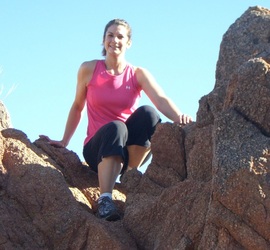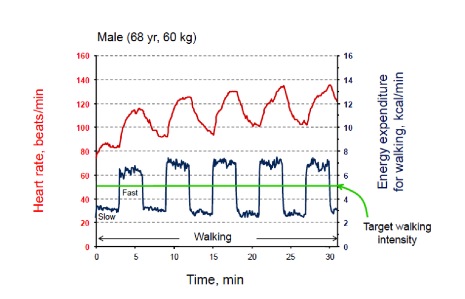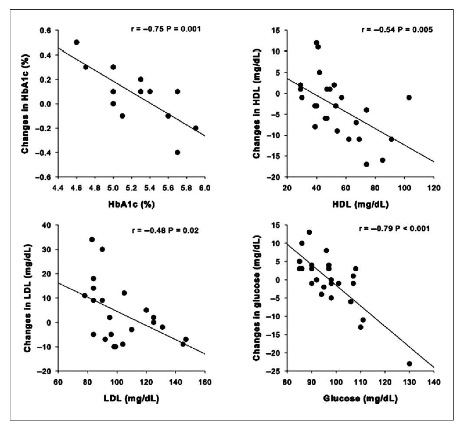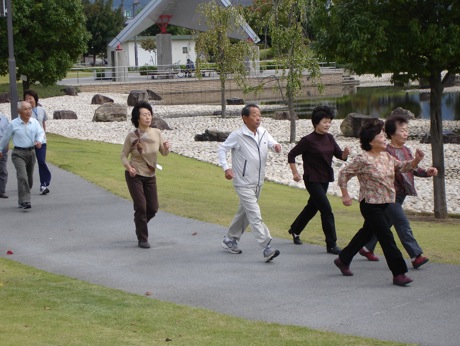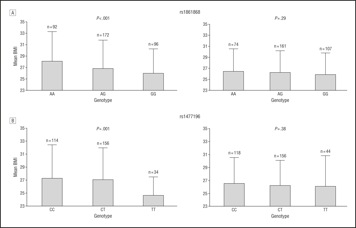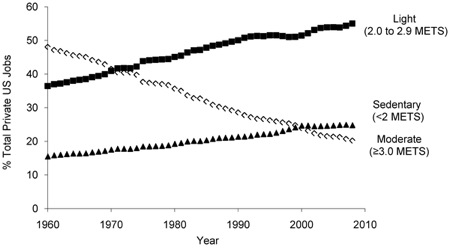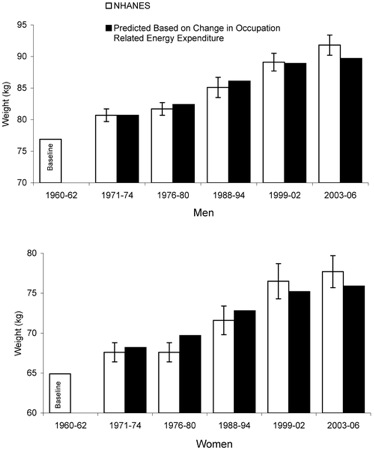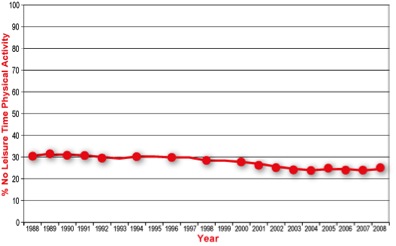Archive for August, 2012
Real Biggest Losers?
Clues from the National Weight Control Registry (NWCR)
A number of my recent posts have focused on the related problems of inactivity and obesity. Losing weight is a hard thing to do and in this post I want to touch on a few things associated with big time sustained weight loss.
Weight loss is hard, studies show that it is possible for many people to lose about 10% of their body weight in structured programs but over the next several years most (about 90%) regain the weight. It is pretty easy to focus on why people regain the weight they have lost and there are all sorts of reasons to explain it, but what about the people who keep the weight off?
The NWCR is open to people over 18 who have lost at least 30 pounds (14kg) and kept it off for at least a year and there is data on more than 10,000 successful long term “losers”. The NWCR site also has some interesting case stories that might be of use for people struggling to lose weight and/or maintain their weight loss.
Here are a few key findings from the NWCR web site.
- 80% of persons in the registry are women and 20% are men. The “average” woman is 45 years of age and currently weighs 145 lbs, while the “average” man is 49 years of age and currently weighs 190 lbs.
- Registry members have lost an average of 66 lbs and kept it off for 5.5 years. These averages, however, hide a lot of diversity:
- Weight losses have ranged from 30 to 300 lbs.
- Duration of successful weight loss has ranged from 1 year to 66 years!
- Some have lost the weight rapidly, while others have lost weight very slowly–over as many as 14 years.
- 45% of registry participants lost the weight on their own and the other 55% lost weight with the help of some type of program.
- 98% of Registry participants report that they modified their food intake in some way to lose weight.
- 94% increased their physical activity, with the most frequently reported form of activity being walking.
- There is variety in how NWCR members keep the weight off. Most report continuing to maintain a low calorie, low fat diet and doing high levels of activity.
- 78% eat breakfast every day.
- 75% weigh themselves at least once a week.
- 62% watch less than 10 hours of TV per week.
- 90% exercise, on average, about 1 hour per day.
What I find interesting is that people who lose a lot of weight and keep it off are exercising about an hour a day. They also appear to be extremely vigilant about their body weight. There is a link to all of the scientific research the NWCR has generate on the web site for those interested in even more data.
When I look at some of the numbers associated with physical activity and the obesity epidemic presented in the earlier posts, the NWCR “biggest losers” would seem to be at the upper end of the guidelines for physical activity. So not getting fat is dependent on high levels physical activity and successful weight loss is dependent on high levels of physical activity.
The other point I want to emphasize is that it is possible for people to regain control of various elements of their lives. It is never too late to be proactive. To emphasize this point, the next section of this post was written by Sheila Ray who is a former co-worker and a successful “loser” and is now a personal fitness trainer and fitness boot camp instructor with her own small business, Reforming U.
Sheila Ray’s Weight Loss Summary
It wasn’t until I was 25 that my 5’8” body began to creep into an unhealthy weight range when I was diagnosed with breast cancer. The surgeries, chemotherapy and radiation were physically and mentally difficult. I was fatigued, which meant I was 100% inactive. I was also warned not to lose weight, so I continued to eat. This was a disastrous combination and I slowly ballooned to 221 pounds, where I stayed for several years.
In 2002, I decided to jump on the “low carb” craze and lost 37 pounds, bringing me down to 184. I didn’t incorporate exercise until after this weight loss, when I began to exercise regularly. There was a problem though. I didn’t realize how strong I was. I didn’t push myself. I became too comfortable with my exercise routine and didn’t see continued results. I also found I couldn’t sustain the “low carb” diet and went back to eating the way I used to eat. Although I stayed faithful to my exercise program, I slowly added weight back on over the next five years and found myself back at 197 pounds.
In early 2008, I began to learn more about health and wellness. I educated myself on a well-balanced life, including healthy, whole nutrition, as well as effective and safe exercise programs. I took control of my life and created happiness like I’ve never experienced before. I cleaned up my diet by eliminating processed foods, laden with chemicals and artificial ingredients, and took control of my daily calorie intake.
I also discovered my strength and began to push myself in my workouts, seeing positive results. I discovered change is not comfortable and I had been comfortable for far too long. I also found my self-pride and self-confidence, because I could do things I never knew possible.
Over six months during 2008, I dropped 40 pounds, which I have been able to maintain. In order to maintain this weight loss, I continue to be aware of the number of calories I consume and burn each day. While I may not be as vigilant as I was during my weight loss phase, I do have a solid understanding of the amount of food and activity I need for that delicate maintenance balance. I eat three well-balanced meals, starting with breakfast within 30 minutes of waking. I also eat one to two snacks between meals, ensuring I do not go more than four hours without eating during the day. I weigh myself often and use clothing as a guide. I exercise four to six days per week, mainly utilizing interval training, with bursts of high intensity activity mixed with active recovery. My passion is helping others achieve the happiness I have.
Before
After
Interval Walking Training
In several recent posts I have focused on physical activity and health and also the link between obesity and inactivity. Not a lot of good news if you look at the population statistics, but good news if you think about just how protective exercise and physical activity are both in terms of obesity and also general health. So, what to do about it?
Perhaps the easiest, cheapest and most convenient form of exercise for most people, especially middle aged (40-65) and older (>65) people is simply walking. One of the best and most effective ways to get the most out of your walking is to do something called Interval Walking Training (IWT). This program was developed in the Japan by my close friend and colleague Hiroshi Nose, and his research team to help thousands of people get into better shape.
The idea is to use the same principles that elite endurance athletes and Olympians do when you go for a walk. To get in the best shape possible the elites do work outs that include multiple 3-5 minute efforts that are nearly all out followed by 2-3 minutes of recovery several times or more per week. Both scientific studies and practical experience suggests that this is a key to getting in the best possible shape. It also gives you incredible “bang for the buck” in terms of time, and what works for the elite athletes can work for us all.
The IWT program consists of 5 or more sets of 3 minutes of low-intensity walking followed by fast walking for 3 minutes four or five times per week. Low intensity walking should be a bit faster than a stroll (40% effort) and higher intensity walking should be at greater than 70% of maximum effort. Hiroshi’s team has used this approach in a number of their studies and they use heart rate monitors and tracking devices called accelerometers to set and measure exercise intensity.
The figure below is one that shows a typical heart rate response and calorie consumption pattern with this type of training in one of the subjects in Japan. It was sent to me by Dr. Shizue Masuki and the data was collected by Dr. Ken Miyagawa, they are both key members of the Nose team. Hiroshi had the following comments about the data:
“As shown in the figure, HR increases to ~130 beats/min during fast walking, but decreases during slow walking, This slow walking or recovery period is important because it motivates a subject to walk at high intensity again. Moreover, because the interval walking training was performed in a hot environment (atmospheric temperature=32 C, RH=60%), HR level increases with increasing body temperature, which makes it difficult to estimate walking intensity from HR accurately. Therefore, it is important to monitor walking intensity with a tri-axial accelerometer.”
Does this work? To quote one of the early papers on IWT:
“In the IWT group, isometric knee extension increased by 13%, isometric knee flexion by 17%, peak aerobic capacity for cycling by 8%, and peak aerobic capacity for walking by 9%, all of which were significantly greater than the increases observed in the moderate-intensity continuous walking training group. Moreover, the reduction in resting systolic blood pressure was higher for the high-intensity interval walking training group.”
Below is a figure from a collaborative study that we did with the team from Japan. It shows what happens to selected inactivity associated risk factors when 26 previously sedentary people (average age 54) followed the program about four days per week for three months. The people with the worst initial values for HbA1c (a diabetes related marker), HDL cholesterol, LDL cholesterol and glucose showed the biggest improvements with IWT. We also found big increases in exercise capacity and reductions in blood pressure. So, it worked!
In an article in the New York Times on what the best form of exercise Professor Nose put what IWT can do for people in laymen’s terms.
“Physical fitness — maximal aerobic power and thigh muscle strength — increased by about 20 percent which is sure to make you feel about 10 years younger than before training…….symptoms of lifestyle-related diseases (hypertension, hyperglycemia and obesity) decreased by about 20 percent, and depression scores dropped by half.”
I am closing with a shot of a beautiful park in Matsumoto, Japan where the Nose team is located and where many of the subjects he studies do their walking.
Why Did Lance Throw In The Towel?
I want to follow up on Friday’s post on Lance Armstrong abandoning his legal challenges to United States Anti Doping Agency (USADA) case against him. Armstrong has a “take no prisoners” reputation and the question on everyone’s mind is why the ultimate no quit person, quit? Here are some thoughts:
- Once his legal challenge in U.S. federal court was rejected he could no longer play offense and essentially put USADA on trial. This means that he could no longer control the process and expose the limitations of drug testing and use the idea that he was targeted for extra testing to his advantage.
- Cycling has had a doping problem for a long, long time and at some level he likely believes that all he was doing was ensuring he and his team had a level playing field. Here is a link to a graphic on recent doping bans in the Tour de France. Lance was not alone, and I bet he feels like whatever he did it was more than justified. It reminds of a quote by Vito Corleone in the Godfather:
- Bill Katovsky sent me a something from Slate.com about how Lance can continue to be outraged and point to the many drug tests he passed and the fact the Feds did not indict him after a two plus year investigation. Again, who cares what USADA says, he controls the story.
- Battle fatigue associated with constantly being investigated. Mitch Jackson an attorney from Southern California sent me this e-mail and also commented on Friday’s post:
“Litigation can be a nightmare… even for those people who have done nothing wrong. I have no idea what Lance did or didn’t do but even though I have 27 years of successful litigation experience under my belt, I think the last thing I’d want to do is try and defend myself overseas in this particular arena on this particular issue.”
- Lance looked at it objectively and figured a small percentage of people really care about the details of what did or did not happen with doping in his tour victories. The average person looks at it a bit like professional wrestling and all they care about is the uber narrative of Lance as heroic cancer survivor. In the long run his brand depends on this and he can go on being rich and famous and doing good things for the world at large no matter what USADA says. The support shown by his sponsors is consistent with this interpretation. So the smart move was to punt.
- The sportscaster Seth Everett sees the whole doping story in the context of brand protection by the leagues and international federations and likens it to the speed limit. Without drug testing everyone is trying to go 80 when the speed limit is 65. With doping control most people go 65 and a few can get away with going a few miles an hour over the speed limit.
- About my idea that a “Truth Commission” might used to change the culture and get to the bottom of the doping problem, reaction was mixed. Gretchen Reynolds gave it a positive Tweet, but George Brose who runs a great website on old time track and field felt that Truth Commissions were best used in situations associated with true evil like Rwanda. I still think a Truth Commission should be explored. The current system is not working and until someone gets to the bottom of the doping culture, the cat and mouse game will continue.
I think the seven points above cover most of what has or has not been said about the Lance situation. Life will go on for us all, the doping circus will continue and from my perspective a number of things that could have been done to make things better and learn from this and other doping situations have not been done. Next week, the plan is to refocus on issues related to exercise, health and how to make life better for the rest of us.
Lance Armstrong: What Really Happened – Spreecast with Seth Everett
I had a great time today participating on a Spreecast with Seth Everett to discuss the recent news on Lance Armstrong.
http://www.spreecast.com/events/lance-armstrong-what-really-happened/embed-large
Lance Throws In The Towel
Who would have thought that Lance Armstrong would throw in the towel in his drug case? Last month I briefly reviewed the pros and cons of the case and I was waiting for things to heat up in the next few months before I commented again. The pro Lance arguments go:
- He passed a gazillion drug tests.
- The federal investigation of him was abandoned making many people think there was no clear money trail that could be followed to support allegations of doping. Systematically beating doping control with blood transfusions is logistically complicated and can’t be cheap. So if the feds could not find a money trail maybe there wasn’t one.
The anti Lance arguments go:
- The drug tests are beatable (ask Marion Jones). So passing drug tests proves nothing.
- How could he dominate for so long and in many cases so decisively in a sport where a high percentage of the people he was beating were actually caught doping?
- Some of the power outputs that top people were doing during mountain stages in the Lance era are at the edge of what might be physiologically possible and are probably physiologically impossible.
- Rumors, rumors, rumors, rumors and would a guy like Lance ever “unilaterally disarm” if he thought the rest of the world was doping?
Here is what I thought might happen that did not. I expected a federal judge to rule that United States Anti Doping Agency (USADA) was essentially an arm of the government. As an arm of the government USADA needed to follow certain standards of due process and that they were not. Lance then gets USADA in court and forces them to admit the limitations of drug testing and that he passed a bunch of tests even though he had been targeted for extra testing. There are also a number of credible expert witnesses who could easily have shot holes in some of the blood count numbers that USADA had deemed suspicious.
So then it would have been about what his ex-teammates were willing to say and how all of it sounded to a jury. A good lawyer could have had a field day. A star struck jury buys the arguments Lance and his team make and it is Lance 1, USADA 0.
For the younger people reading this post I thought of one precedent, Tarkanian vs. the NCAA, and have been surprised that no one in the mainstream media has made the connection. The basketball coach Jerry Tarkanian was in essentially a 20 plus year range war with the NCAA about claims of recruiting and other violations in the high profile college basketball programs he ran. He sued using some of the rationale I outlined above and eventually the case went to the U.S. Supreme court. Tarkanian lost there, but he was never banned from coaching and won a settlement from the NCAA based on claims that they were persecuting him. A lot of parallels with what might have happened had Lance pressed on.
Another issue that has been largely ignored by the mainstream media is how the whole issue of doping in sport, especially cycling, might have been handled differently. One idea is that there should have been a truth commission. In other words let everyone come clean, tell what they did, name names, and try to learn everything there is to learn about both the technical and cultural aspects of doping. Don’t strip anyone of medals or titles but get the truth out and improve the testing and compliance programs. Only go after the people who refuse to come clean.
The truth commission approach has been used to promote social reconciliation in places like post apartheid South Africa. Maybe it could have been used to clean up high level sport as well.
There is more than one way to define a level playing field, and in this era of rampant doping the athletes and those around them have been trying to define it themselves. Failing to use the truth commission or a related approach means that the cat and mouse enforcement games go on and that it is just a matter of time until there is another Marion Jones or Lance Armstrong. I believe the athletes want clean competition and that the key to this is fixing the culture which will require more than better drug tests.
Inactivity and Obesity
This post is on how inactivity is a major player in the obesity epidemic. It is data rich so fasten your seat belts. That having been said, I want to make three main points:
- Physical inactivity is an extremely recent experience for humans as a species.
- People with high levels of physical activity are protected from obesity.
- A loss of physical activity at work as we all become desk jockeys is a big reason why we are getting fatter as a population.
Inactivity is recent.
Dates vary but modern humans emerged out of Africa and began to spread to the rest of the world about 40,000 years ago. For the next 30,000 years essentially we were all hunter gatherers. Based on a variety of estimates, including observations in the few remaining hunter gatherer societies, it appears that many adults hunter gatherers walk between 10 and 20km (6-12 miles) per day. There also appears to be essentially no obesity in these societies. There are complex potential interactions between their activity levels and what they were eating, but many groups of hunter gatherers had access to plenty of food. Granted the variety might have been minimal, but for many there were plenty of calories.
About 10,000 years ago agriculture emerged during something called the Neolithic Revolution. We have at least some idea about the activity levels associated with muscle power (human or draft animal) farming from the Old Order Amish who practice agriculture without the benefit of electricity or tractors but do use horses! It is also pretty clear that they eat an awfully lot of what could be called traditional high calorie farm food. Here is a quote from adapted a classic study on the Old Order Amish.
“The average number of steps per day was 18,425 for men versus 14,196 for women. Men reported 10.0 hours per week of vigorous physical activity, 42.8 hours per week of moderate physical activity, and 12.0 hours per week of walking. Women reported 3.4 hours per week of vigorous physical activity, 39.2 hours per week of moderate physical activity, and 5.7 hours per week of walking. Men had higher levels of energy expenditure than women. A total of 25% of the men and 27% of the women were overweight (BMI > or = 25), and 0% of the men and 9% of the women were obese (BMI > or = 30).”
High levels of physical activity protect against obesity.
The data above mean that most Old Order Amish are essentially physically active all day long most days. Contrast their BMI values with the values for the U.S. population as a whole that I reviewed earlier this week, 35% obese and 60-70% overweight. Another interesting thing about the Old Order Amish is that their high levels of activity protect them from two gene variants that seem to predispose sedentary people to higher BMIs. The left panels on the figure below show that for Old Order Amish in the bottom 50% of physical activity there is a relationship between the gene variants and BMI. The right panels show that for those in the top 50% of physical activity there is no relationship between the gene variants and BMI. Genetic predispositions get blamed for all sorts of things but the environment, culture and lifestyle typically has an even bigger role for most common conditions. Again high levels of physical activity are protective against obesity.
Physical activity at work matters.
The Old Order Amish are people who are clearly active all day long with farming and household chores. They are probably as active or even more active than hunter gatherers were. However, in the last hundred years a muscle powered way of life has vanished for most of us. So, what about the rest of us? It turns out that over the last 50-100 years most of us are doing less and les physical activity at work. The slide below is from a terrific scientific paper on this topic. It shows that as over the last 50 years the number of people employed in jobs associated with moderate physical activity has declined from about 50% to 20%. As the authors note:
“From 1960 to 2008 there was an approximate drop in occupation-related daily energy expenditure of 140 calories for men and 124 calories for women.”
For most of us that is like walking (or not walking) 1 to 1.5 miles during the day. What is even more amazing is how these missing calories add up and explain population based weight gain over the last 40 or 50 years. The figure below also from this paper shows the impact of the missing calories on estimated changes in body weight over time and how the match up with the NHANES population surveys in the U.S. It is incredible how well the numbers match up. It is also incredible what a big impact just over 100 hundred calories a day has.
Summary
Hunter gatherers and traditional farmers were very active and almost none were fat even when there was plenty of food around. However, you don’t have to be that active to avoid the being a statistic in the current obesity epidemic. The data on occupational energy expenditure from the last 50 years shows that burning an extra 100-150 calories a day can have a huge impact on population based body weight statistics. From a practical perspective what would happen if everyone went for a brisk 20-30 minute walk at lunch every day?
Defining Obesity
This is a short post with some definitions and statistics about obesity. They will be helpful to understand upcoming posts on the health consequences of physical inactivity and how inactivity and obesity are linked.
First, what is BMI? BMI stands for Body Mass Index. It is a mathematical formula that factors in height and weight to give a single number that is useful to normalize values for people of different heights. This link is to a CDC site about obesity and BMI. Briefly, a BMI of 20-25 is normal, between 25 and 30 is considered overweight, and more than 30 is obese. BMI is not a perfect way to estimate body composition, for example there can be super muscular people who have high BMIs and are very lean. However, for the population as a whole it seems to work. Here is a link for anyone who wants to take a deeper dive into BMI. Using the table below you can calculate your own value. For anyone used to the metric system the table is in feet and pounds because most of my readers are likely in the U.S.
Second, just how fat are we getting as a population? In the last couple of posts I have talked about the pandemic of inactivity related diseases and just how inactive most people are. Below is a CDC video showing the trends in obesity by state in the U.S. over the last 30 years. You can see there is also an obesity epidemic going on in parallel with the inactivity problem and about 35% of the U.S. population is now obese and somewhere between 60-70% are either overweight or obese. The CDC website has more data on obesity for those who are interested.
click here for video
The data and video speak for themselves and there is no need for much editorial comment except to say it is a very, very disturbing situation. In coming posts I will make the case that less physical activity has caused this problem and that more physical activity and exercise are key to addressing it.
Physical Activity: Are We Getting Enough?
A couple of days ago I discussed whether deconditioning should become a distinct medical diagnosis because it is the root cause of so many devastating chronic diseases. In this short post I want to briefly review how much structured exercise or physical activity is enough and whether people are getting enough?
First, let me briefly comment on exercise and physical activity. They are related but not exactly the same thing. Structured exercise includes things like going to the gym, playing in a sports league of some type, or a planned walk or run. In general, anything that is organized and designed as a workout. Physical activity is a broader way to look at things. In addition to formal exercise, it includes things like riding your bike to work, taking the stairs, household chores, unstructured play and other recreational activities.
Second, what are the guidelines? I am attaching a link to the most recent U.S. guidelines for physical activity. They are designed to prevent the development of many of the chronic conditions that result from inactivity. The key numbers are:
“Adults (18-64) should do 2 hours and 30 minutes a week of moderate-intensity, or 1 hour and 15 minutes (75 minutes) a week of vigorous-intensity aerobic physical activity, or an equivalent combination of moderate- and vigorous-intensity aerobic physical activity. Aerobic activity should be performed in episodes of at least 10 minutes, preferably spread throughout the week.”
There are other ideas and numbers out there, but when you look at them in detail most are pretty similar. The guidelines also include specific recommendations for children and older adults along with ideas about strength training.
Third, how is the population doing as a whole in meeting these guidelines? The short answer is terrible. The next link is to a paper that used accelerometers to measure physical activity as part of the NHANES study and the bottom line is that:
“Among adults, adherence to the recommendation to obtain 30 minutes per day of physical activity is less than 5%.”
Fourth, the chart below from the U.S. Centers for Disease Control shows just how many people get no leisure time physical activity at all. Things appear to be getting a bit better over the last 10 years, but 25% of people are completely inactive and as we saw in the chart from a couple days ago, the biggest improvements in health occur when people go from being completely inactive to doing something.
These statistics are a snapshot of just how bad things are. In my next few posts I am going review how much physical activity is “normal” for humans and what can be done about this huge problem. There are many innovative solutions that are working out in the real world, so there is no need to “sit around” and wait for them to happen.
You are currently browsing the Human Limits blog archives for August, 2012.


